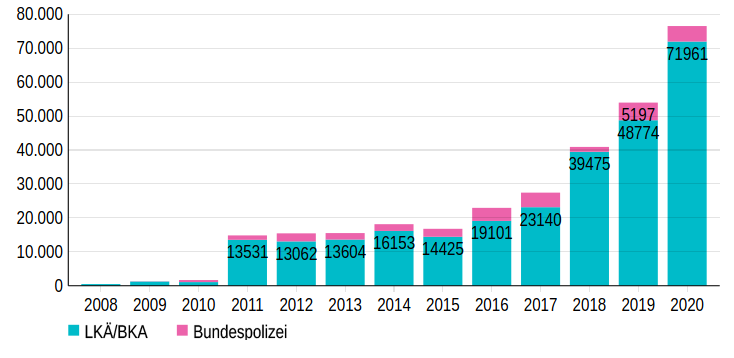Millions of faces, fingerprints and palm prints are stored in German police databases. Law enforcement agencies are also processing more and more biometric data at the EU level.
The comparison of photographs by German police authorities has again increased sharply in the past year. This is shown by statistics based on information provided by the Federal Ministry of the Interior in a parliamentary interpellation. According to this, a total of 76,535 queries were made in the facial recognition system of the Federal Criminal Police Office (BKA) in 2020. The year before, there were still around 54,000 queries, so the increase is more than a third (2018: 41,000, 2017: 27,000). According to the statistics, most of the searches come from the criminal investigation offices, which is also where the greatest increase was recorded.
Since 2009, the BKA has made it possible for the state criminal investigation offices and the Federal Police to identify unknown persons with the help of the central police information system (INPOL-Z). In the database, the BKA stores photographs mainly from the identification service. The “Z” stands for “central file”, which is kept by the BKA but filled by all police authorities.
Number of identified persons increases significantly
Currently, INPOL-Z contains a total of 5.75 million portrait photos of 3.64 million persons. The number of pictures has increased in recent years, but for the last year the BKA records a slight decrease. Although around 650,000 files were added, around 740,000 pictures were removed due to deletion deadlines.
For the time being, the Federal Ministry of the Interior does not disclose the number of persons who were identified with the help of the cross-checking of their photos. This information would “not be held centrally”. The same reason was given for refusing to release the information last year. Upon further enquiry, however, the BKA did find a statistic then. According to it, a total of 2,123 persons were identified in 2019, a doubling compared to the previous year.

For the processing of fingerprints and palm prints, German police authorities operate an “Automatic Fingerprint Identification System” (AFIS), in which 5.3 million personal data records are currently stored. Another DNA analysis file contains more than 1.2 million data records on persons and crime scene evidence.
Hits after searching EU databases
EU databases are also increasingly storing and processing biometric data. Since three years, the Schengen Information System (SIS II) has had an AFIS, it currently contains 286,195 searchable fingerprints. These are linked to various wanted persons from EU member states. Last year, German authorities obtained a total of 5,618 hits from searches of the SIS AFIS – mostly in the context of police checks.
Facial images can also be stored in the SIS II, but these are not yet searchable. With the new version of the SIS II regulation, it should also be possible to enter unknown persons exclusively with biometric data, but this has not yet been technically implemented.
In addition to the SIS II, the Eurodac database also contains searchable fingerprints. Eurodac is an identification system for asylum seekers as well as third-country nationals and stateless persons. Their fingerprints are searched to determine whether asylum applications have been registered with the same biometric identifiers before. As of 30 November, 5.8 million fingerprint sheets were held in Eurodac.
Use for other purposes on the rise
Other biometric data are stored at EU level in the Visa Information System (VIS). Each of the 73.2 million applications contained there is accompanied by a photograph, and there are also 64.3 million fingerprint sheets in the visa file.
Eurodac and VIS can also be used beyond asylum and visa matters. Law enforcement agencies can use them to prosecute serious crimes, for example. The number of such applications has increased significantly in recent years. While there were 827 applications for the VIS in 2015, the Federal Ministry of the Interior recorded a total of 4,075 applications for 2017. Last year, this figure was 1,998.
Finally, Interpol also set up a facial recognition system a few years ago; according to the German Federal Ministry of the Interior, a corresponding database currently records around 82,000 photographs (2019: 69,000). These are taken from the warrants received by Interpol and made searchable. The BKA had initially not agreed to the storage and processing of German data. The answer now issued leaves it unclear whether the “technical and data protection examination” for participation in the Interpol system is continuing or whether the BKA has now definitively rejected it.
Image: “Mugshot screenprint 2” by angus mcdiarmid (CC BY-NC 2.0).





Leave a Reply